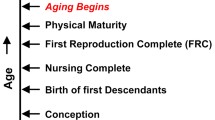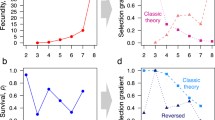Abstract
In the modulation of longevity by natural selection there is a trade-off between the investment of resources in the maintenance of the body, or soma, and the investment in reproduction. There is accumulating evidence that long-lived mammalian species have much more efficient maintenance than short-lived ones. It is also clear that short-lived ground-living mammalian species reproduce very much more quickly than larger long-lived species, and in all mammals there is an inverse relationship between maximum reproductive potential and maximum longevity. These features of life-history strategies very strongly support the disposable soma theory of the evolution of ageing. Slow development and large size are associated with delayed ageing. If the environment changes, for whatever reason, small rapidly breeding species are able to adapt and survive much more easily that large slow breeding species. This can explain the very well documented extinction of many large mammalian species during the Pleistocene. In an environment which remains constant for a long period of time, selection favours the evolution of larger species, but these are put at risk if the environment becomes less favorable. Fluctuating environments are more likely to promote the evolution of small short-lived species with high fecundity.
Similar content being viewed by others
References
G Barja A Herreo (2000) ArticleTitleOxidative damage to mitochondrial DNA is inversely correlated to maximum lifespan in the heart and brain of mammals FASEB J 14 312–318 Occurrence Handle10657987
AD Barnosky PL Koch RS Feranec SL Wing AB Shabel (2004) ArticleTitleAssessing the causes of late Pleistocene extinctions on the continents Science 306 70–74 Occurrence Handle15459379
GP Burness J Diamond T Flannery (2001) ArticleTitleDinosaurs, dragons and dwarfs: the evolution of maximal body size Proc Natl Acad Sci USA 98 14518–14523 Occurrence Handle11724953
R Holliday (1989) ArticleTitleFood, reproduction and longevity: is the extended lifespan of calorie restricted animals an evolutionary adaptation? BioEssays 10 125–127 Occurrence Handle2730632
R Holliday (1994) Longevity and fecundity in eutherian mammals MR Rose CE Finch (Eds) Genetics and the Evolution of Ageing Kluwer Academic Publishers Dordrecht 217–225
R Holliday (1995) Understanding Ageing Cambridge University Press Cambridge
R Holliday (1996) ArticleTitleThe evolution of longevity in man Perspect Biol Med 40 100–107 Occurrence Handle8946763
R Holliday (2003) The modulation of lifespan by natural selection SIS Rattan (Eds) Modulating Ageing and Longevity Kluwer Academic Publishers Dordrecht 17–26
P Kapahi ME Boulton TB Kirkwood (1999) ArticleTitlePositive correlation between mammalian life span and cellular resistance to stress Free Radic Biol Med 26 495–500 Occurrence Handle10218637
TBL Kirkwood (1977) ArticleTitleEvolution of ageing Nature 270 301–304 Occurrence Handle593350
TBL Kirkwood (1981) Repair and its evolution: survival versus reproduction CR Townsend P Calow (Eds) Physiological Ecology: An Evolutionary Approach to Resource Use Blackwell Scientific Oxford 165–189
TBL Kirkwood R Holliday (1979) ArticleTitleThe evolution of ageing and longevity Proc Roy Soc B 205 532–546
TBL Kirkwood R Holliday (1986) Ageing as a consequence of natural selection KJ Collins AH Bittles (Eds) The Biology of Human Ageing Cambridge University Press Cambridge 1–16
RDE MacPhee (Eds) (1999) Extinction in Near Time: Causes Contexts and Consequences Kluwer/Plenum New York
Medawar PB (1952) An Unsolved Problem in Biology. Lewis, London. Reprinted in Medawar PB (1981) The Uniqueness of the Individual. Dover, New York
R Pamplona M Portero-Otin C Ruiz R Gredilla A Herrero G Barja (2000) ArticleTitleDouble bond content of phospholipids and lipid reoxidation negatively correlate with maximum longevity in the heart of mammals Mech Ageing Dev 112 169–183 Occurrence Handle10687923
R. Pamplona M Portero-Otin JR Requena SR Thoprpe A Herrero G Barja (1999a) ArticleTitleA low degree of fatty acid unsaturation leads to lower lipid peroxidation and lipoxidation-derived protein modification in heart mitochondria in the longevous pigein than the short-lived rat Mech Ageing Dev 106 283–296
R Pamplona M Portero-Otin D Riba F Ledo R Gredilla A Herrero G Barja (1999b) ArticleTitleHeart fatty acid unsaturation and lipid peroxidation, and ageing rate are lower in the canary and parakeet than in the mouse Ageing (Milano) 11 44–49
RO Prum (2003) ArticleTitleDinosaurs take to the air Nature 421 323–324 Occurrence Handle12540882
RG Roberts TI Flannery KA Ayliffe H Yoshida JM Olley GJ Prideaux GM Laslett A Baynes MA Smith R Jones BL Smith (2001) ArticleTitleNew ages for the last Australian megafauna: continent-wide extinction about 46,000 years ago Science 292 1888–1892 Occurrence Handle11397939
AJ Stuart (1991) ArticleTitlemammalian extinctions in the late Pleistocene of northern Eurasia and North America Biol Rev Camb Phil Soc 66 453–462
GC Williams (1957) ArticleTitlePleiotropy, natural selection and the evolution of senescence Evolution 11 398–411
Author information
Authors and Affiliations
Corresponding author
Rights and permissions
About this article
Cite this article
Holliday, R. Ageing and the extinction of large animals. Biogerontology 6, 151–156 (2005). https://doi.org/10.1007/s10522-005-3458-6
Received:
Accepted:
Issue Date:
DOI: https://doi.org/10.1007/s10522-005-3458-6




